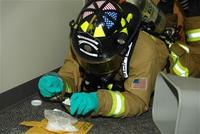-
Population growth a challenge to secure supplies of energy, food, water
Mention great challenges in feeding a soaring world population, and thoughts turn to providing a bare subsistence diet for poverty-stricken people in developing countries. An expert says, however, that there is a parallel and often-overlooked challenge: the global population will rise from seven billion today to almost nine billion people by 2040. Providing enough food to prevent starvation and famine certainly will be a daunting problem.
-
-
Bird flu mutation study offers vaccine clue

Scientists have described small genetic changes that enable the H5N1 bird flu virus to replicate more easily in the noses of mammals. So far there have only been isolated cases of bird flu in humans, and no widespread transmission as the H5N1 virus cannot replicate efficiently in the nose.
-
-
Footwear safety reflectors help in detecting bioterror threats

Tiny versions of the reflectors on sneakers and bicycle fenders that help ensure the safety of runners and bikers at night are moving toward another role in detecting bioterrorism threats and diagnosing everyday infectious diseases, scientists said the other day.
-
-
Arsenic contamination in food and water supplies
After virtually eliminating arsenic as a useful tool for homicide, science now faces challenges in doing the same for natural sources of this fabled old “inheritance powder” that contaminates water supplies and food, threatening more than thirty-five million people worldwide.
-
-
Concerns grow over repeated safety failures at U.S. BioLabs
According to a report that was released by the Government Accountability Office (GAO) late last month, the United States is at a high risk for accidents at laboratories which conduct research on potential bioterror germs such as anthrax because federal officials have failed to develop national standards for lab design, construction, and operation.
-
-
Farm states pass bills to protect farms from activists, whistle-blowers
In an effort to stop animal rights activists from recording acts of animal cruelty on farms, lawmakers in twelve states have proposed or enacted bills which would make it illegal secretly to record livestock farms or apply for a job at a farm without disclosing ties to animal right organizations.
-
-
L.A County to turn rain water into drinking water
Residents of Los Angeles County know that on the rare occasion that it rains, staying away from the beach is a good idea. Runoff from rain typically brings heavy metals, pesticides, cigarette butts, animal waste, and other pollutants into the streams and rivers which go into the Pacific Ocean. Now, local officials are getting together to find a solution to the water pollution and water scarcity, with an ambitious plan to make the runoff water drinkable.
-
-
Finding the right tools to respond to suspicious powder incidents

HazMat teams across the United States respond to hundreds of white powder calls each year in large cities where quick decision-making is critical. DHS makes it easier to buy the right technology for bio-threat incidents.
-
-
New device will quickly detect botulinum, ricin, other biothreat agents
Researchers are developing a medical instrument which will be able quickly to detect a suite of biothreat agents, including anthrax, ricin, botulinum, shiga, and SEB toxin. The device, once developed, approved by the Food and Drug Administration (FDA), and commercialized, would most likely be used in emergency rooms in the event of a bioterrorism incident.
-
-
China catches 12 times more fish beyond its waters than it reports
Chinese fishing boats catch about $11.5 billion worth of fish from beyond their country’s own waters each year — and most of it goes unreported. Researchers estimate Chinese foreign fishing at 4.6 million tons per year, taken from the waters of at least ninety countries — including 3.1 million tons from African waters, mainly West Africa.
-
-
Same-day water test keeps beaches open, swimmers’ health protected

With warm summer days at the beach on the minds of millions of winter-weary people, scientists are reporting that use of a new water quality test this year could prevent unnecessary beach closures, while better protecting the health of swimmers.
-
-
Nanobiotechnology kills listeria, other food-borne pathogens, dead
Researchers, using nature as their inspiration, successfully attached cell lytic enzymes to food-safe silica nanoparticles, and created a coating with the demonstrated ability selectively to kill listeria — a dangerous foodborne bacteria that causes an estimated 500 deaths every year in the United States. The coating kills listeria on contact, even at high concentrations, within a few minutes without affecting other bacteria.
-
-
Genetically engineered multi-toxin crops make insects insecticide-resistant
The popular new strategy of planting genetically engineered crops that make two or more toxins to fend off insect pests rests on assumptions that do not always apply, researchers have discovered. Their study helps explain why one major pest is evolving resistance much faster than predicted and offers ideas for more sustainable pest control.
-
-
New foot-and-mouth vaccine shows promise
The 2001 foot and mouth outbreak in Britain was devastating and cost the economy billions of pounds in control measures and compensation. One recommendation in a Royal Society report following the epidemic recommended the development of new approaches to control the virus. Scientists have used a new method to produce a vaccine which does not rely on inactivating the live, infectious virus which causes the disease — and is therefore much safer to produce.
-
-
More than 10,000 pesticides approved by EPA without rigorous review
Congress allowed the Environmental Protection Agency (EPA) to use what is called “conditional registration” to approve pesticides deemed especially beneficial for food production – even before all the toxicity tests have been completed. Congress intended conditional registration to be used only sparingly, but the EPS has been using the loophole in a wholesale fashion to approve 65 percent – or more than 10,000 – of the 16,000 pesticides submitted to it for approval. The EPA cannot easily track the history of conditionally approved pesticides to determine whether required toxicity data was submitted, whether that caused a dangerous use of a pesticide to be cancelled, or whether the uses or restrictions should be modified based in such data.
-
More headlines
The long view
Ransomware Attacks: Death Threats, Endangered Patients and Millions of Dollars in Damages
A ransomware attack on Change Healthcare, a company that processes 15 billion health care transactions annually and deals with 1 in 3 patient records in the United States, is continuing to cause massive disruptions nearly three weeks later. The incident, which started on February 21, has been called the “most significant cyberattack on the U.S. health care system” by the American Hospital Association. It is just the latest example of an increasing trend.
